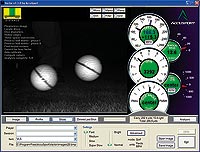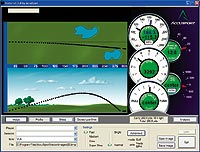Club Performance Fitting, Taking Fitting To A Higher Level
First in a series of articles on this new fitting method
By Ed Mitchell, Mitchell Golf Company
The newest method for club fitting is fast becoming known as “club performance fitting”. This differs from what has been the industry “standard” of using demo clubs with different stock shafts in a variety of lengths and lie angles. Henry-Griffitts was the frontrunner by introducing this method in 1988. It gained momentum and was made popular by major club manufacturers in recent years. It wasn’t until 1999 that every name brand manufacturer offered a club-fitting cart. At first, the carts had too many options. The choices were too confusing. It was said that you could find several “fits” for the same golfer from within the many demo clubs. Slowly the options were reduced to a more manageable number. But the fitting process remained the same with an emphasis only on length, lie and shaft flex.
What is “club performance fitting”? One might say club fitting is coming into the technical age. Some major club companies travel the country with tech vans and fit clubs on site. In recent years a couple of companies have offered fitting services with science vans outfitted with expensive proprietary launch monitors. Armed with an abundance of technical data, these companies offered the ultimate fit matching their club with their ball for maximum distance.
Even though the launch monitor has been around for several years, its use is just now becoming more common. Not only has the software become friendlier to use, but the cost and portability of launch monitors has made it practical for golf professionals and club fitters to use with their club sales programs. There are now several models that can be used outdoors on a range where ball flight can be observed.
However, the greatest influence that is driving this new fitting method is the popularity of aftermarket golf shafts. Shaft manufacturers have taken their products to the tour in large numbers during the past few years. It’s only been about 15 years since True Temper and Precision were the only shaft makers with a trailer following the tour. Back then they were competing for use of their steel shafts by tour professionals. Today with many composite shaft makers having a presence on tour, pros have a smorgasbord to select from. Golfers of all abilities are seeking this same advantage that’s enjoyed by touring pros. It has become very fashionable to retrofit popular brand drivers with the hottest composite shafts used on tour regardless of cost.
That brings us to the answer of what “club performance fitting” is all about. Golfers are demanding the same custom club fitting tour pros receive each week at the tour trailers. They want the same advantage of matching club head, shaft, and ball so they can maximize their ability to hit it as far as they possibly can. So in technical terms, “club performance fitting” is defined as “matching club head performance (size, loft, lie & face angle) to shaft performance (length, flex, weight, bend point, & frequency) with a golf ball that produces the highest ball speed launched at the optimum angle with the appropriate spin rate.”
Did I confuse you? Remember what I said about too many choices in the original fitting carts? It might seem we have returned to that same confusing method. But actually, we have stepped into the technical age. Launch monitors easily identify the best performance combinations of heads, shafts and balls. The software even illustrates what changes are needed to enhance performance.
Ball speed has the most influence on how far the golf ball will travel. But launch angle and spin rate of the ball must be appropriate to achieve maximum distance. Club head loft has the most influence on launch angle. Typically the best shot from today’s oversized Titanium driver is a launch angle of about 15 degrees with around 2600 rpm’s of spin. Spin rate is actually a derivative of ball speed. Your ideal numbers will depend on how fast you swing the club head.
The “club performance fitting” method is a process of elimination just like the old method. But with launch monitor data fitting results can be quantified. The benchmark for “club performance fitting” starts with testing your existing driver. With an evaluation of your club head speed, ball speed, launch angle, and spin rate, your professional fitter can easily put you into demo clubs that will enhance your distance. Then it simply becomes a matter of finding the optimum club head loft, shaft and ball combination.
From the matrix of demo drivers, select the head with enough loft to give you the best launch angle and one that appeals to your eye. Don’t get hung up on a certain name brand just because someone else plays that club. Next match a shaft that produces the ball speed, launch angle, and spin rate that results in the greatest distance. Then experiment with golf balls to see if you can gain more distance.
Today’s new club fitters have become known as “Club Performance Fitting Specialist”. Find one who uses a launch monitor and find out if your performance results are lacking.
In my next article I will discuss “club performance fitting” examples that further define this new technically superior fitting method. These examples have been compiled from Mitchell Golf’s Club Performance Fitting Specialist training school. The students offer a wide range of performance factors. It shows a direct correlation between the fitting parameters of club head speed, ball speed, launch angle and spin rate. Graphs will be used to illustrate the results. In the meantime find a specialist who offer’s “club performance fitting” and improve your driving distance.


